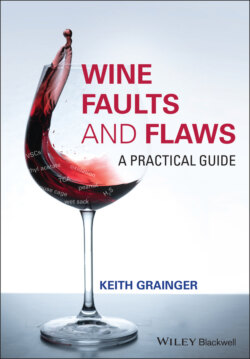Читать книгу Wine Faults and Flaws - Keith Grainger - Страница 52
2.5 Appearance 2.5.1 The Appearance Assessment
ОглавлениеThe first stage in a tasting assessment is to examine the appearance. This can reveal much about the wine and give indications as to the origin, style, quality, and maturity, as well as revealing some possible faults. Faults that are or may be detectable on the appearance are shown in Table 2.1. This list is not exhaustive.
Table 2.1 Some faults detectable on appearance of wine.
| Visual indicator | Possible fault | Refer to: |
|---|---|---|
| Browning, loss of colour (red wines), ‘flat’ or dull appearance | Oxidation | Chapter 5 |
| Deepening of colour (white or sparkling wine) | Oxidation Lightstrike | Chapter 5 Chapter 6 |
| Unexpectedly light colour | Atypical ageing | Chapter 8 |
| Unexpected bubbles, sludgy sediments | Fermentation in bottle | Chapter 9 |
| Haze | Presence of yeast or bacteria. Unstable proteins | Chapter 10 |
| Cloudy appearance with brown tinges | Heat damage | Chapter 14 |
Wine appearance should be examined in several ways, including holding the glass at approximately 30° from the horizontal over a white background, a tablecloth or sheet of white paper, as illustrated in Figures 2.1 and 2.2. This will enable the clarity, the intensity of colour, and the true colour of the wine to be seen, uncorrupted by other colours in the room. Figure 2.1 shows a vibrant purple cask sample – Château Margaux 2017 (photograph taken in April 2018). Figure 2.2 shows a 40 years old Margaux – Château Lascombes 1979 (photo taken in February 2020).
Figure 2.1 A cask sample Margaux – Ch. Margaux 2017.
Figure 2.2 A 40 years old Margaux – Ch. Lascombes 1979.
